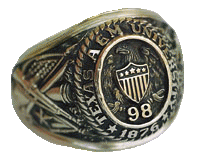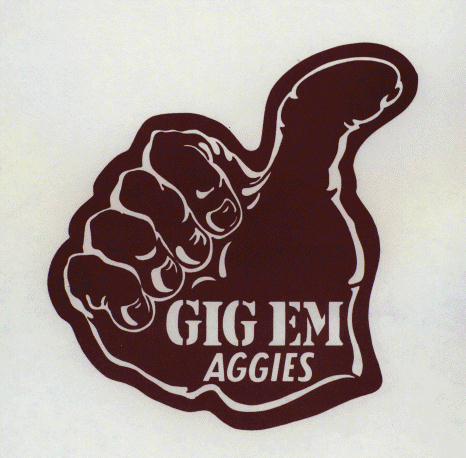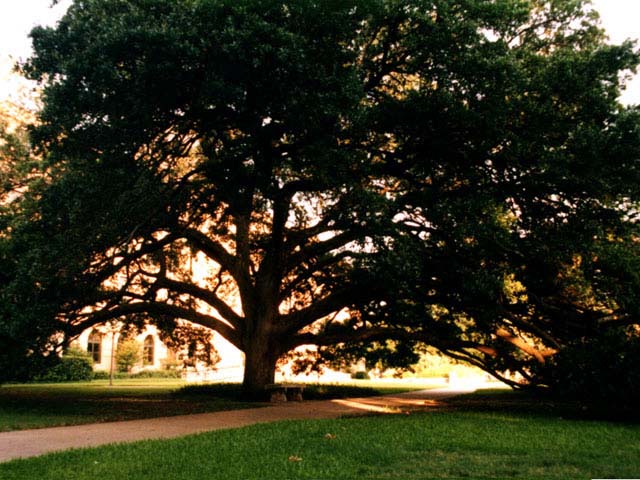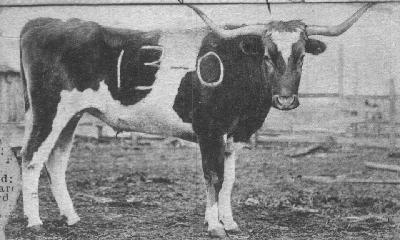| |
|
 |
Howdy! One of the many traditions here at A&M.
Everyone greets one another with this friendly saying as they pass on
campus, start a meeting, or have any kind of event where a bunch of good
ol' ags are bunched up in a room. |
|
|
|
|

|
The 12th Man
The tradition of the Twelfth
Man was born on the second of January 1922, when an underdog Aggie team
was playing Centre College, then the nation's top ranked team. As the
hard fought game wore on, and the Aggies dug deeply into their limited
reserves, Coach Dana X. Bible remembered a squad man who was not in
uniform. He had been up in the press box helping reporters identify
players. His name was E. King Gill, and was a former football player who
was only playing basketball. Gill was called from the stands, suited up,
and stood ready throughout the rest of the game, which A&M finally won
22-14. When the game ended, E. King Gill was the only man left standing
on the sidelines for the Aggies. Gill later said, "I wish I could say
that I went in and ran for the winning touchdown, but I did not. I
simply stood by in case my team needed me."
This gesture was more than
enough for the Aggie Team. Although Gill did not play in the game, he
had accepted the call to help his team. He came to be thought of as the
Twelfth Man because he stood ready for duty in the event that the eleven
men on the gridiron needed assistance. That spirit of readiness for
service, desire to support, and enthusiasm helped kindle a flame of
devotion amoung the entire student body; a spirit that has grown
vigorously throughout the years. The entire student body at A&M is the
Twelfth Man, and they stand during the entire game to show their
support. The 12th Man is always in the stands waiting to be called upon
if they are needed.
This tradition took on a new
look in the 1980's when Coach Jackie Sherrill started the 12th Man
Kick-Off Team composed of regular students through open tryouts. This
12th Man team performed very well and held opponents to one of the
lowest yards per return averages in the league. Later, Head Coach R.C.
Slocum changed the team to allow only one representative of the 12th Man
on the kick off team. The 12th Man tradition also took musical form. The
12th Man sings this song after each game in which the Aggies are
outscored. |
|
 |
The Aggie Ring
One of the greatest moments in
the life of any Aggie is the day that they receive their Aggie Ring.
This moment began with the Class of 1889. The original ring is very
different from the ring worn today. At that time several companies made
several different versions of the Aggie Ring. It wasn't until E. C.
Jonas, class of 1894, designed a ring for his class that the ring we
know today came into existence. It has remained exactly as Jonas
designed it, with one exception; in 1964 the Legislature of the State of
Texas changed the university's name from the Agricultural and Mechanical
College of Texas to Texas A&M University, and the name on the ring was
changed accordingly.
The Aggie Ring is one of the
most symbolic of our traditions. Everything seen on the ring represents
a value that an Aggie should hold. On the top is a large shield, which
symbolizes the desire to protect the reputation of the university.
The 13 stripes on the shield
represent the 13 original states of America. The five stars on the
shield refer to the phases of development of any Aggie: mind or
intellect; body; spiritual attainment; emotional poise; and integrity of
character.
The eagle symbolizes agility
and power, and the ability to reach great heights. The large star on the
side of the ring symbolizes the Seal of Texas. The five-pointed star is
encircled with a wreath of olive and laurel leaves symbolizing
achievement and a desire for peace. The live oak leaves symbolize the
strength to fight for our country and our state. The leaves are joined
at the bottom by an encircling ribbon to show the necessity of joining
these two traits to accomplish one's ambition to serve.
An ancient cannon, a saber, and
a rifle are on the other side of the ring and symbolize how citizens of
Texas fought for their land and are determined to defend it. The saber
stands for valor and confidence, while the rifle and cannon stand for a
preparedness and defense. The crossed flags of the United States and
Texas recognize an Aggie's dual allegiance to both nation and state.
Traditionally, students wear
their ring with the class year facing them to signify the fact that
their time at A&M is not yet complete. During Senior Weekend at the
annual Ring Dance, the student's ring is turned around to face the world
proudly, just as the Aggie graduate will be ready to face the world.
|
|
 |
Aggie Bonfire
Bonfire first began in the
early 1900's as a symbol of the Aggie Spirit.
It was first created as a pile of wood and trash when the football was
returning on the train from a game. The cadets decided to make a
Bonfire to congratulate the team on their win. This first Bonfire was
held in the early morning hours of November 18, 1907.
Bonfire grew immensely through
the years. The largest Bonfire was in 1969 when it stood 109ft., only
one foot shorter than Rudder tower. After that, the administration
decided to regulate the Bonfire height to 55ft.
There have been two years that
Bonfire has not burned. First, in 1963,
following the death of President John F Kennedy, the senior class made
one of the most difficult decision of their time at Texas A&M. In honor
of their president, they decided to dismantle the Bonfire, which had
been recently completed. The head yell leader at the time, Mike Marlowe,
was quoted as saying, "It is the most we have and the least we can
give."
The second time that Bonfire was built and did not burn was
November 18, 1999, Bonfire fell taking 12 of our fellow Aggies with
it.
This day was one of the most trying days for Aggies everywhere. Aggies
around the world united in one Spirit to get through these terrible
times. At this time, Bonfire has been postponed indefinitely. No one
knows if Bonfire will return. At this point, Aggies must stay united
and support one another in the many other Traditions that make A&M so
unique. The Aggie Spirit has created the Aggie Traditions and that
Aggie Spirit will thrive through the trying times. |
|
 |
|

|
Corp of Cadets
Texas A&M was established as a military
institution, and the Corps of Cadets has played an important part in its
history and development. Although membership in the Corps became
voluntary in 1965, Texas A&M historically has produced more military
officers than any other institution in the nation except for the service
academies.
The Corps of Cadets at Texas
A&M is not just another ROTC unit as might be found on most campuses.
The 2,200 men and women of the Corps form the largest uniformed body of
students outside the U.S. military academies. Although cadets can earn
commissions as military officers, membership in the Corps itself carries
no military obligation. In fact, only about 30 percent of graduating
cadets are commissioned, while the rest pursue civilian careers.
The Corps has more to offer
than just military training. It is a tightly-knit group of students that
offers camaraderie as well as leadership training that is useful in all
post-college careers. All Corps activities and organizations are open to
all qualified applicants regardless of gender, and the Corps encourages
female participation.
Texas A&M has rich military
history. More than 200 of its graduates have become generals or
admirals. More Aggies were commissioned and fought in World War II than
men from West Point or Annapolis.
|
|
 |
Gig'em! Pinky Downs, class of 1906 and
a member of the Board of Regents from 1923 to 1933 is credited with the
Gig'em hand sign. Downs was at the 1930 Yell Practice before the TCU
game and shouted out "What are we going to do to those Horned Frogs?".
His muse did not fail him as he improvised, borrowing a term from frog
hunting. "Gig 'em, Aggies!" he said as he made a fist with his thumb
extended straight up. The gesture became the first hand sign of The
Southwest Confernce. |
|
 |
Aggie Muster
Aggies gathered together on
June 26,1883 to live over again their college days, the victories and
defeats won and lost upon the drill field and in the classroom. By April
21, 1903, this annual gathering evolved into a celebration of Texas'
Independence on San Jacinto Day. These early meetings included field
games and banquets for Aggies to reflect and celebrate their memories of
Aggieland. 'Let every alumni answer a roll call' wrote the former
students. It was not until 1922, however, that April 21 became the
official day of events for all Aggies, thus, the annual tradition of
Muster was born. The March 1923 Texas Aggie urged, 'If there is an A&M
man in one-hundred miles of you, you are expected to get together, eat a
little, and live over the days you spent at the A&M College of Texas.
Still remembering and honoring
the time spent in Aggieland, the tradition of mustering has grown in
strength, meaning, and spirit. By 1929, meeting had grown worldwide, and
in 1942 Aggie Muster gained international recognition. Twenty-five men,
led by General George Moore '08, mustered during the Japanese Siege of
the Philippine island of Corregidor. Knowing that Muster might soon be
called for them, these Aggies embodied the essence of commitment,
dedication, and friendship- the Aggie Spirit. They risked their lives to
honor their beliefs and values. That small group of Aggies on an outpost
during World War II inspired what has developed into one of our greatest
traditions.
Muster is celebrated in more
than four-hundred places world wide, with the largest ceremony on the
Texas A&M campus in College Station. The ceremony brings together more
Aggies, worldwide, on one occasion than any other event.
The students of Texas A&M
University coordinate the Campus Muster. Because Muster was established
to bring Aggies together, each Campus Muster is dedicated to the
fifty-year reunion class. The Campus Muster involves an entire day of
activities for students both present and past. Alumni enjoy a special
program including tours of the ever-changing campus. At noon, all Aggies
congregate at the Academic Plaza for the Camaraderie Barbecue that
rekindles the tradition of the original Muster celebration. That night,
the Muster ceremony consists of an address by a keynote speaker, the
reading of poems, followed by the Roll Call for the Absent. The Roll
Call honors Aggies that have fallen since the last Muster roll was read.
As the names are read, a friend or family member answers 'Here', and a
candle is lit to symbolize that while those Aggies are not present in
body, they will forever remain with us in Aggie Spirit.
Century-old roots provide the
basis of Muster as Aggies know it today. It has changed, yet the Spirit
in which it was established remains the same. Since the beginning, every
Aggie has lived and become a part of the Aggie Spirit. What is felt
today is not just the love of a fellow Aggie, it is the spirit of
hundreds of thousands of Aggies who have gone before. Muster is how that
Spirit is remembered and will continue to unite Texas A&M and the Aggie
family. A&M may change, but the Spirit never will. |
|

|
|
 |
A&M Mascot Reveille
Reveille, the first lady of
Aggieland, is the official mascot of Texas A&M University. She is the
highest ranking member of the Corps of Cadets, and she is a Five-Star
General. Reveille I came to Texas A&M in January 1931. A group of cadets
hit a small black and white dog on their way back from Navasota. They
picked up the dog and brought her back to school so they could care for
her. The next morning, when "Reveille" was blown by a bugler, she
started barking. She was named after this morning wakeup call. The
following football season she was named the official mascot when she led
the band onto the field during their half-time performance. When
Reveille I died on January 18, 1944, she was given a formal military
funeral on the gridiron of Kyle Field. She was then buried at the north
entrance to the field, as all Reveilles are, facing the scoreboard so
that she can always watch the Aggies outscore their opponent. Before
naming Reveille II, there were several other unofficial mascot, such as
Tripod, Spot, and Ranger. It was not until a later Reveille that she was
a full-blood Collie. The most current Reveille is Reveille VII and was
inducted in 2001.
Reveille is the most revered
dog on campus. Company E-2 has the privilege of taking care of Reveille.
If she is sleeping on a cadet's bed, that cadet must sleep on the floor.
Cadets address Reveille as "Miss Rev, m'am." If she is in class and
barks while the professor is teaching, the class is to be immediately
dismissed. Reveille is a highly cherished mascot and receives only the
best. |
|
 |
Silver Taps
By far, one of Texas A&M's most
honored traditions is Silver Taps. Silver Taps is held for a graduate of
undergraduate student who passes away while enroolled at A&M. This final
tribute is held the first Tuesday of the month when a student has passed
away the previous month.
The first Silver Taps was held
in 1898 and honored Lawrence Sullivan Ross, the former governor of Texas
and president of A&M College. Silver Taps is currently held in the
Academic Plaza. On the day of Silver Taps, a small card with the
deceased students name, class, major, and date of birth is placed as a
notice at the base of the academic flagpole, in addition to the memorial
located behind the flagpole. Around 10:15 that night, the lights are
extinguished and hymns chime from Albritton Tower. Students silently
gather at the statue of Lawrence Sullivan Ross. At 10:30pm, the Ross
Volunteer Firing Squad marches into the plaza and fire a twenty-one gun
salute. Buglers then play a special rendition of Silver Taps by Colonel
Richard Dunn. Taps is played three times from the dome of the Academic
Building: once to the north, south, and west. It is not played to the
east because the sun will never rise on that Aggie again. After the
buglers play, the students silently return to their homes. Silver Taps
is a sacred tradition that Aggies hold dear. |
|
 |
Fightin' Texas Aggie Yell
Practice
Yell Practice began as a post
dinner activity in 1913, when different corps companies would gather
together to "learn heartily the old time pep." However, it was not until
1931, that Yell Practice as is known today, was held before the t.u.
game. It began, when a group of cadets were gathered in Peanut Owen's
dorm room in Puryear Hall. Someone suggested that all of the freshmen
should fall out and meet on the steps of the YMCA building at midnight.
The cadets notified senior yell leaders Horsefly Berryhill and Two Gun
Herman from Sherman, who could not authorize it, but said that they may
just show up. Well, needless to say, the word spread quickly, and when
the freshmen began to arrive, there were railroad flares and torpedoes
stuck in flower pots around the YMCA building to light the area. The
first Midnight Yell had begun!!!
Today, Midnight Yell is held
the night before a home game in Kyle Field and at the Grove on Thursday
nights before away games. Also for away games, a site is designated for
a Midnight Yell in the city of our opponent on the night before the
game. For example, for the t.u. game, it is held at the Texas Capitol in
Austin. For a yell at Kyle Field, yell leaders lead the Fightin' Texas
Aggie Band and the Twelfth Man into the stadium. The yell leaders lead
the crowd in old army yells, the singing of the fight song, and tell
fables of how the Aggies are going to beat the everlivin' hell out of
our opponent for the next day. Lastly, the lights go out, and Aggies
kiss their dates. If they don't have a date, all they have to do is
flick their Bicks. As the story goes, the flames make it easier for two
dateless people to find each other, and maybe they won't be dateless
anymore!
The purpose of Midnight Yell is
to pump up the Twelfth Man for the next day's big game! |
|
 |
Old Century Tree
The Century Tree has been a
major fixture on Texas A&M's campus since Old Army Days. Located in
Academic plaza between Hart and Legett Residence Halls, it has become a
favorite romantic spot among students. As the legend goes, if two lovers
walk underneath the tree's massive branches together, it is a sign that
they will eventually marry. Moreover, If two lovers propose under the
Century Tree, it is a sign that their marriage will last forever.
|
|
 |
tu's Mascot Bevo
One of the most famous
longhorns in the state is Bevo, the mascot of the University of Texas.
He got his name when, after a
football game in 1916, Aggies branded the score, 13-10, on a longhorn
steer. UT students changed the brand to "BEVO." |
|

|
Texas Aggie Yell Leaders Although nationally known for
their spirit, the Texas Aggies have no cheerleaders. This is because
they have no school cheers. Instead, there are a variety of school yells
used by the 12th Man team (the student body) in support of the team on
the field or court. Each year 5 students (three seniors and two juniors)
are elected by the student body to serve as Yell Leaders.
|
|
|
|
|
 |
Standing for America
The Red, White and
Blue Out was a tribute to the victims of the September 11th terrorists
attacks. Fans in the upper deck wore red t-shirts, while white was worn
in the middle deck and blue in the lower deck. Kyle Field was flooded
with the colors of the American flag for the September 22, 2001 home
game versus Oklahoma State. The event was created and pulled of by a
group of current students in just under two weeks. Over $150,000 was
raised from t-shirt sales and donated personally to New York Fire
Department Charities.
|
|
All pictures and information courtesy of Texas A&M
University. |
|
|




